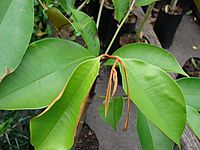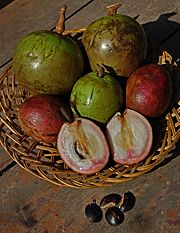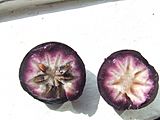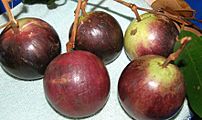Chrysophyllum cainito facts for kids
Quick facts for kids Chrysophyllum cainito |
|
|---|---|
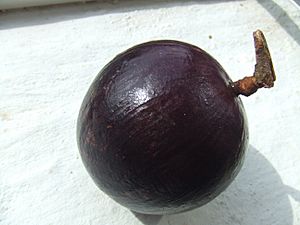 |
|
| Chrysophyllum cainito fruit | |
| Scientific classification | |
| Genus: |
Chrysophyllum
|
| Species: |
cainito
|
The Chrysophyllum cainito is a tropical tree known for its delicious fruit, often called the star apple. This tree is part of the Sapotaceae family. It first grew in the Isthmus of Panama and was later brought to other places. Now, you can find it growing in many warm, tropical areas around the world, including the Caribbean and Southeast Asia. The star apple tree grows quite fast and can reach up to 20 meters (about 65 feet) tall!
What's in a Name?
The star apple fruit has many different names! The most common names, cainito and caimito, probably come from old Maya languages words. These words describe the fruit's juicy, milky sap.
People also call it by other fun names like tar apple, purple star apple, golden leaf tree, and milk fruit. In Vietnam, it's called Vú Sữa, which means milky breast because of its milky juice. In Sierra Leone, it's known as Bobi Wata, also meaning "Breast Milk Fruit." In Malayalam, it's called Swarnapathry, meaning [the tree with] golden leaves, which describes its shiny leaves. In Cambodia, it's Phlae Teuk Dos, meaning milk fruit. In Hong Kong and China, people call it 牛奶果 (milk fruit) or 金星果 (golden star fruit).
About the Star Apple Tree
The Tree Itself
The star apple tree has evergreen leaves, which means they stay green all year round. These leaves are oval-shaped and can be 5 to 15 centimeters (2 to 6 inches) long. What's really cool is that the underside of the leaves shines with a golden color, especially when you see them from a distance!
The tree also has tiny flowers that are purplish-white. They have a sweet, pleasant smell. The star apple tree is special because it is hermaphroditic, meaning each tree can produce fruit all by itself without needing another tree for pollination.
The Fruit
The star apple fruit is round and usually about 5 to 7.5 centimeters (2 to 3 inches) across. When it's ripe, the skin is often a beautiful purple color, with a lighter green area near the stem.
If you cut the fruit in half, you'll see a cool star pattern inside the white or purplish pulp! This is where the name "star apple" comes from. While most fruits are purple, you can also find some with greenish-white or yellow skin.
It's important to know that the skin and the outer part of the fruit are not good to eat because they contain a sticky, milky sap. The seeds inside are flat, light brown, and hard. Star apples are a seasonal fruit, meaning they are only available at certain times of the year.
People love to eat star apples fresh as a dessert. They are sweet and taste best when chilled. In some places, parts of the tree, like the leaves or bark, are used in traditional medicine. For example, the fruit has properties that are good for you, like antioxidants.
There are different types of star apples. The purple ones usually have a thicker skin and a firmer texture. The greenish-brown fruits have thinner skin and more liquid pulp. The yellow variety is less common.
In Vietnam, a very famous type of star apple is called Lò Rèn milk fruit. It comes from a specific area called Vĩnh Kim commune in Tiền Giang Province.
Gallery
See also
 In Spanish: Caimito para niños
In Spanish: Caimito para niños


